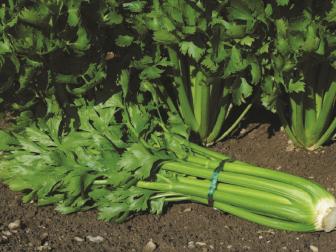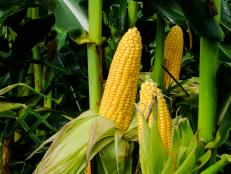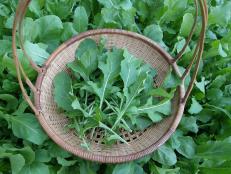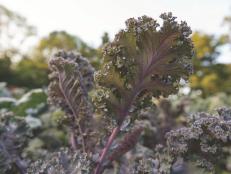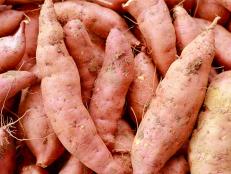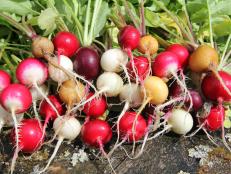How to Grow Celery
Find tips for turning a challenging celery crop into a high-yielding harvest with tips and tricks for growing celery.
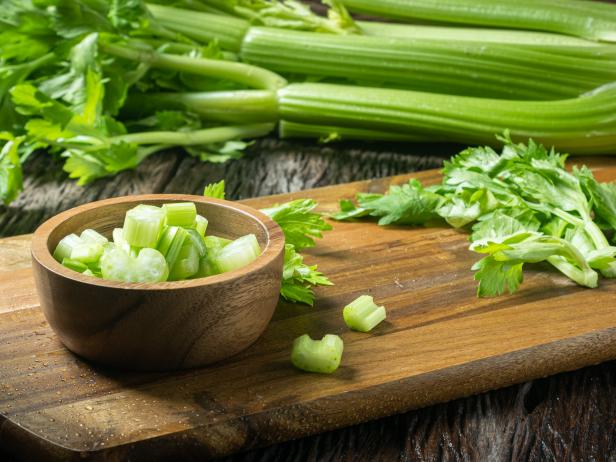
Shutterstock/Sakoodter Stocker
What You Need to Know to Grow Celery
Of all the garden crops, celery probably has one of the worst reputations for being difficult to grow. The truth is that celery isn't that much of a diva — it's just a little different from the majority of veggies. As long as you understand what it needs (plenty of moisture and rich soil), you can grow your own crop of crunchy goodness.

Baker Creek Heirloom Seeds at RareSeeds.com
Why should you try growing celery? First, because fresh-from-the-garden celery will send your tastebuds on a delectable trip. Homegrown celery delivers intense flavor that just can't be compared with its store-bought cousins. When you dry the leaves, they retain that amazing taste, really punching up winter roasts and soups.
Growing celery also gives you the option to try some really fun and different types, especially if you grow it from seed. Pink Chinese celery blends color and flavor and makes a stunning addition to a crudité platter.
Another reason to grow celery is because you can dig and overwinter plants in pots in a root cellar or non-freezing cold frame and enjoy fresh celery all winter long. Or maybe you'll grow it for the thrill of conquering the challenge. Whatever your reason for raising this crunchy veggie, here's what you need to know to grow celery successfully.
When Celery Grows Best
Celery doesn't grow well with heat, but yields best in regions with cool summers, long falls or mild winters. Typically it's grown as a summer crop (spring planting) in cool northern areas. In the South, gardeners usually plant it in early fall for a winter harvest. Everywhere else, it's usually raised for a fall crop (spring planting).
Celery takes a long time to mature: 130 to 140 days. Sometimes gardeners with a long growing season raise a second crop in fall by starting seeds indoors in May or June and tucking transplants into the garden in June or July. With this crop, it's vital to shade seedlings during the hottest part of the day.
How to Preserve Celery
How to Grow Celery From Seed
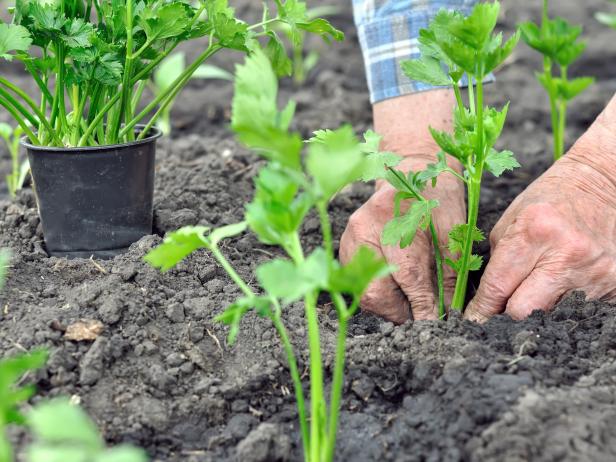
Shutterstock/Yuris
The secret to getting celery seed to sprout is soaking seeds for 24 to 48 hours before planting. When sowing, barely cover seeds or even leave them uncovered. Germination occurs in seven days with soil temps of 70 degrees Fahrenheit.
Planting Celery Seedlings
Give celery a spot in full sun for best growth. In the hottest regions, shade plants during the hottest part of the day. Celery needs a rich soil with lots of organic matter. Plants have a small, shallow root system that's only 2" to 3" deep with a spread of 6" to 8". This means that you want to give the plant what it needs to thrive in those first few inches of soil.
Amend the planting bed with plenty of compost or rotted manure, adding more compost to each planting hole. Space plants 8 inches apart. You can grow roughly 12 plants in 5' to 6' of row space. In a raised bed, you can even tuck them along one end or in the corners.
Don't plant celery seedlings in the garden until day temperatures stay reliably above 55 degrees Fahrenheit and nights are above 40 degrees Fahrenheit. If you plant too early and the weather becomes cold (under 55 degrees Fahrenheit) for two weeks, seedlings may bolt and form seed.
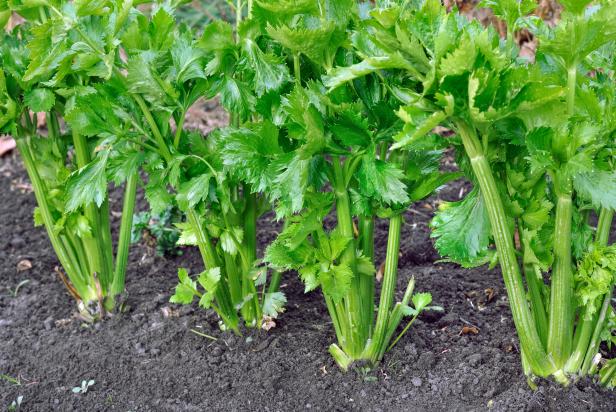
Shutterstock/Yuris
Another alternative for growing celery is simply to use a stalk you buy at the store. Cut off the bottom 2 inches of the stalk, tuck the root end into a pot of soil or your garden, water and wait for it to grow. Just make sure you don't put plants outside until it's warm enough.
Tips for Growing Celery
- Water: Celery must not dry out, or it becomes bitter and stringy. Dry spells also produce pithy or even hollow stems. Give plants a consistent moisture supply. Working compost into soil helps soil to retain water.
- Mulch: Adding a mulch layer around celery plants helps soil stay moist longer and protects shallow roots from drying.
- Fertilizer: Keep celery growing steadily by feeding it throughout the growing season with a balanced fertilizer such as fish emulsion or 5-10-10. Apply fertilizer once during the second and third month of the crop cycle. You can also water plants with manure tea weekly.
- Weeding: Celery's shallow roots means that it doesn't compete well with weeds. Keep the planting area free of weeds. Mulch can help with suppressing weeds.
Blanching Celery
Blanching is the process of covering the celery stalk to keep sunlight from reaching the stems. Doing this shifts stem color from deep green to light green and changes stem flavor from bitter to sweet. It yields a celery that tastes more like what you would buy from the store. When you blanch celery, stems stretch upward, which helps reduce stringiness. Unblanched celery has a stronger flavor (it can shift to bitter) and also more nutrients in those dark green stems. The time to blanch celery is anywhere from 10 to 21 days before harvesting.
To blanch celery, cover the upright stems, keeping the leaves uncovered so they continue to photosynthesize and feed the plant. Unleash your creativity for this task. All you need is some kind of sleeve to slip over the plant. Some gardeners use empty cardboard cartons (milk, juice, etc.) with the bottom removed to slide over stems. Others wrap cardboard or newspaper around stalks and secure it with ties or string.
You can also mound soil against stems, which is what many celery farmers do. Old-fashioned celery growing methods involve planting celery at the base of a trench that you gradually fill with soil to blanch stems. When you use soil to blanch, be sure to wash your celery very well.
Self-blanching varieties are often meant to be planted in blocks, so the plants shade one another. Their stalks tend to be less stringy. These varieties do yield a sweeter stem without blanching, but stem flavor sweetens even more with blanching.
How to Harvest Celery
Pick celery at any point during the growing season, whenever plants are large enough to suit what you need. Pick individual stalks from the outside of the clump. To harvest whole plants, cut them at the soil line, or pull up the whole plant and trim the roots.
Watering plants the day before harvest improves flavor and storage. Celery typically keeps in the refrigerator for a couple of weeks; even longer in a root cellar. For the longest fridge storage, wrap stalks tightly in foil and tuck into the vegetable crisper.
Protect Celery From Frost
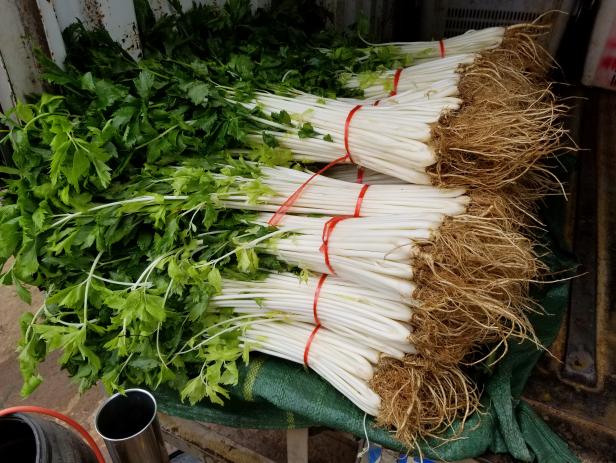
Baker Creek Heirloom Seeds at RareSeeds.com
Celery can only withstand light frost if it's covered with a frost blanket. For long winter storage and fresh celery all winter long, dig a few plants before the first hard frost. Tuck each one into a deep nursery pot. Place them in a cool, non-freezing place for winter (root cellar, unheated basement, cold frame). Ideal storage temps are 35 degrees Fahrenheit to 40 degrees Fahrenheit. Water only when stems wilt. Harvest as needed.
Celery Varieties
You can find many celery varieties available from vegetable seed vendors. These are just a sampling.
- 'Chinese White' or 'Pink'— Heirloom celery varieties from China (white, above; pink shown near top of article). Grow faster than traditional green types; stalks have stronger flavor and tend to be thinner. Also known as cutting celery. Heat resistant. Grows to 31 inches tall.
- 'Golden Self-Blanching'— 1885 heirloom variety from Kenya. Thick, heavy stalks without strings. Grows 24" to 28" tall. Disease resistant. Blanching improves flavor.
- 'Tall Utah 52-70R'— Reliable variety (1953) yields sturdy, tasty stalks. Flavor improves with blanching. Grows 18" to 24" tall.
- 'Tango'— Tender stalks are super crunchy, sweet and less stringy. Stands up to temperature fluctuations and less-than-ideal conditions better than older varieties. Disease resistant. Grows 15" to 18" tall.
- 'Ventura'—Improved 'Tall Utah' type. Early variety with strong stems and tender heart. Sweet flavor, good crunch. Disease resistant and resists bolting. Grows 24" to 30" tall.







